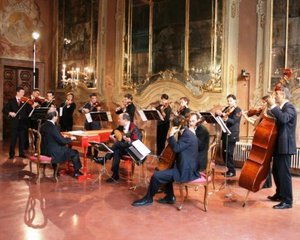|
Back
Off With His Head! New York
Isaac Stern Auditorium, Carnegie Hall
02/07/2017 - & November 8, 2016 (Bruxelles), February 4, 2017 (Urbana)
Antonio Vivaldi: Juditha triumphans devicta Holofernis barbarie, RV 644
Delphine Galou (Judith; Contralto), Mary-Ellen Nesi (Holofernes; Mezzo-soprano), Francesca Ascioti (Ozias; Contralto), Ann Hallenberg (Vagaus; Mezzo-soprano), Silke Gäng (Abra; Mezzo-soprano)
TENET (Women’s Choir), Julie Greenleaf (Artistic Director), Venice Baroque Orchestra, Andrea Marcon (Music Director/Conductor)

Judith from Nuremberg Chronicles
“JEWISH PRINCESS FLEES AFTER BEHEADING ASSYRIAN GENERAL!!”
Headline in Babylon Enquirer, February 7, 601 B.C.E.
Antonio Vivaldi’s resurrection from the sloughs of mediocrity is wide-spread and long overdue. A decade ago, he was that minor Baroque composer who wrote the same concerto over and over again. Or worse, Vivaldi was the name of a Web browser.
But after Cecilia Bartoli delved into the archives and recorded a few of his endless gorgeous songs, the world gave another look. Last summer, Glimmerglass Opera gave the American premiere of his opera, Catone in Utica. Next week, even Bangkok is joining in this new life, with their Royal Philharmonic Orchestra playing a sinfonia, Al Santo Sepolcro, the depths of which could have come from a Bach Passion.
Last night, as part of La Serenissima Festival celebrating Venice, the Venice Baroque Orchestra gave the Carnegie Hall (and perhaps New York) premiere of Vivaldi’s only extant oratorio, the gory quasi-Biblical tale of Holofernes, a bloodthirsty Assyrian General assailing a Jewish town. To seek revenge, Judith, a widowed princess of the town, woos the General, he falls for her, he drinks too much, goes to sleep and is beheaded.
The plot is simple, but Vivaldi’s execution (yes, pun intended) makes it a two-hour musical spectacle. Not with the stage grandiosity, since this is an oratorio. Nor the grandness of a Messiah or Elijah, for not a single aria can match those of Handel or Mendelssohn. Not even with the vocal forces, since the women’s chorus has only four numbers, and the cast has a mere five singers.
The large orchestra, though, makes up for that. Not only drums, trumpets and rare clarinets. But, thanks to the period instruments of the Venice Baroque Orchestra, we had whole consorts of theorbos, viols, a chalumeau, a mandolin, and both harpsichord and organ, with Johannes Keller dashing from one to the other.
And since Vivaldi wrote this for the Ospedale della Pietà–an orphanage which approximated a female version of Juilliard, and one of the miracles of 18th Century Venice–the women’s voices, soothing and wooing, praying (and preying) had a singular texture. These were not the 18th Century castrati, so badly replicated these days by counter-tenors. Judith was written for young absurdly talented females, by a composer who knew their voices and exactly how his lines would be handled.

Venice Baroque Orchestra (© Courtesy of the Artists)
Andrea Marcon, the conductor and founder of Venice Baroque Orchestra, is a master organist, but his gracious conducting stance, his lovely string ensemble and–at start and finish–some intense brass and drums (so different from the popular bucolic Vivaldi) gave this an operatic feeling.
Ironically, the two protagonists were given inferior music to the more emotional melodies and recitatives of their servants. Vagaus and Ozias, sung by Ann Hallenberg and Francesca Ascioti, gave all the dramatic impetus to the story. Ms. Ascioti, showing doubts, prayers and confidence in her Judith, was a stunning contralto, though she was outdone by a single aria given to Vagaus, the assistant to Holofernes.
“Armatae face”, her song of revenge after seeing “his” headless General, is one of Bartoli’s favorites. And while nobody can repeat the word-for-word clarity of the great Cecilia, Ms. Hallenberg turned her mezzo here into a fiery engine, a coloratura display that flamed throughout the auditorium. A gift for Baroque opera-lovers here.
Our Assyrian General, played by Mary-Ellen Nesi, was suitably Butch, starting with bloodthirsty vengeance, and inevitably, seduced by the Jewish princess, turned lulling, effectively soft and finally–glass in hand–drunk, tottering to his seat.
Judith herself? Nobody could doubt the purity of Delphine Galou, whether accompanied by mandolin or chalumeau or the entire orchestra, though Vivaldi’s librettistg made Judith perhaps too much a Goody Two-Shoes. Just before decapitating the General, she humbly sung about purity, and fasting (the Assyrian feast, she sung, would not be suitable for an ascetic religious lass like herself).
And giving thanks and humility and prayer to the One God, the Lord of Hosts, who would help her whack the head off her enemy.

Botticelli’s Judith with Abra and... er, souvenir (© Naples Art Museum)
True, the audience laughed when Judith asked her maidservant to carry the head (“What is this?” sung Abra). Yet such was the beauty of the melodies, the fine coordination of the Orchestra and the highly emotional choruses from TENET that the two hours flew by like Judith fleeing from the bloody tent to the refuge of her town.
How will this oratorio compare with Monteverdi’s Poppea, Handel’s Agrippina or other vocal works later this week? It is different, more stylized (every song, without exception, was a A-B-A da capo structure), less human. But within its own terms Judith proved yet another jewel in the resurrected body of works by Venice’s Red Priest.
Harry Rolnick
|